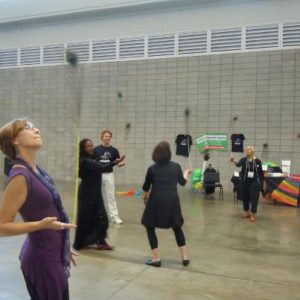We’re just back from a Play conference where hardly anyone played. There were over one hundred sessions, and according to the topics, people talked about play, gave research papers about play, offered strategies for breaking down barriers to play, and suggestions for designing playgrounds for play. But from what I saw in the public spaces, there weren’t too many people actually playing.
What happens when we actually play? In our workshop (or what we would prefer to call, “playshop”) we explored InterPlay tools for multigenerational play. Participants let go of their self-consciousness, and fear of looking foolish (we call this having a willingness to play) and moved into the present moment with a breath and a sigh, a shape and a shake, a laugh and a song.
We noted and experienced the bonding that results from a following and leading game between toddlers and their caregivers, between grandparents and their grandchildren, between people of any age from different cultures. And when we experienced moments of blending, when no one could tell who’s leading and who’s following, we noted these are skills necessary for healthy relationships at any age. We practiced interruption, when the connection is dropped or severed, (scary stuff for our inner child), and experienced reassurance in the reconnection.

A special play expert, a “Playcologist” came to one of our workshops and invited us to stop by his exhibit afterwards. Though it wasn’t easy to find, we persisted through the back dark corner of the convention center. Gary Auerbach’s table was colorful and welcoming, full of inviting toys; hula hoops, scarves for juggling practice, Frisbees (he’s the World Frisbee Champ) and peacock feathers. (You probably didn’t know a feather could be a toy!)
“Throw, throw, catch, catch – crisscross, apple sauce.” We practice a cross lateral movement as he teaches us to juggle and I am reminded that this movement is recommended for brain development in children and continued brain activation as we age. Harder and more athletic than it looked, our attempts to juggle generated lots of laughter among this group of “women of a certain age,” as we kept dropping the scarves and stooping to pick them up.
“Now try two scarves in one hand and one in the other; throw, throw, throw, catch.” Just like in Interplay – you start off simply, and then add complexity. And that thrilling sense of gaining mastery isn’t just for kids. We all loved the triumph of becoming able to juggle three scarves at a time. And the peacock feathers – I discovered I had a special skill, easily balancing one on my palm, then on one finger, and (though I didn’t quite master this), balancing the 3 ft. feather on my nose.

